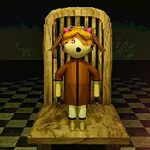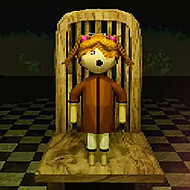Play Things puts you in the middle of a quiet nightmare disguised as routine testing. You arrive in a sterile room, a single bell on the desk, a clipboard in hand. Your task seems simple—evaluate dolls using a strict set of procedures—but something about these tests feels wrong. Every creak, whisper, and flicker of movement keeps you questioning what’s real and what’s part of the experiment.
The Five Mandatory Evaluations
Each doll arrives with a numbered checklist. You must complete every stage before marking your decision. The procedure demands focus and discipline:
• Sound Examination: Lean in and listen. Some dolls hum softly; others remain too still, as if waiting for you to make the first move.
• Name Call: Speak its name aloud. The silence afterward can be more disturbing than any response.
• Photo Inspection: Use the camera. A clear image is rare—distortions, shadows, or extra shapes sometimes appear.
• Temperature Test: Touch the porcelain or fabric. When the surface feels warm, it’s never a good sign.
• Contact Observation: Hold the doll for a few seconds. If your skin prickles or your vision blurs, mark the results carefully.
Once the tests are complete, you must classify the doll: Safe or Dangerous. It sounds simple—but with each evaluation, the facility feels colder, and your certainty begins to fade.
Psychological Pressure and Atmosphere
Play Things excels at creating dread through suggestion rather than shock. The room’s faint hum, the ticking clock, and the way shadows move slightly when you’re not looking—all of it builds unease. There are no instructions on what happens if you misclassify a doll, but the tone of the intercom suggests you don’t want to find out. The deeper you progress, the more the environment itself seems to react to your actions, as if watching your every move.
Effective Testing Strategies
Survival in Play Things depends on observation and emotional control. Consider these strategies as you perform your duties:
• Maintain Routine: The process feels safer when you follow it strictly, step by step.
• Watch for Patterns: Repeated sounds or movements may indicate an underlying rule within the experiment.
• Document Reactions: Writing down small details can reveal connections you might miss under stress.
• Do Not Rush: Haste leads to mistakes—and mistakes have consequences.
• Expect the Unexpected: Objects in the room can change between tests. Accept it. Adapt quickly.
Why Play Things Leaves a Lasting Impression
Few titles capture psychological tension as effectively as Play Things. It disguises fear beneath procedure, letting dread build slowly through routine actions. Each session lasts less than an hour, but the atmosphere lingers long after you finish. The combination of methodical gameplay, hidden story fragments, and unnerving design creates an experience that feels intimate, personal, and deeply unsettling. In Play Things, even following the rules may not keep you safe—but breaking them feels far more dangerous.













 Fullscreen
Fullscreen


